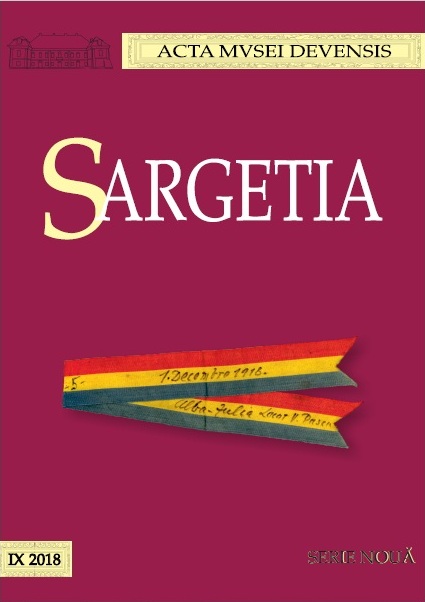Analiza antropologică, arheozoologică
și datarea radiocarbon a unor materiale osteologice din sud-vestul Transilvaniei
Anthropological and Archaeozoological Analysis and Radiocarbon Dating of Several Osteological Materials from South-Western Transylvania
Author(s): Andrei Dorian Soficaru, Adrian Bălăşescu, Oana GAZA, Tiberiu Bogdan SAVA, Corina Anca Simion, Mihaela Culea, Maria Ilie, Cristian Mănăilescu, Doru PĂCEŞILĂ, Gabriela Sava, Andrei Robu, Cătălin Cristescu, Ioan Alexandru BărbatSubject(s): History, Archaeology
Published by: Editura Altip
Keywords: south-western Transylvania; archaeological research; osteological materials; interdisciplinary analysis; prehistory;
Summary/Abstract: The present study presents the investigations of some osteological assemblages from the deposits of the Museum of Dacian and Roman Civilisation, Deva, and the National Museum of Transylvanian History. Chronologically, the materials belong to contexts from the final stage of the Early Iron Age (EIA) and, possibly, to the period of the early La Tène communities. Therefore, the approach focused on the osteological materials found at Bacea – Sărături (Fig. 10-11), Hărău (Fig. 1, 12-13), Simeria (Fig. 2-4, 14) and Șoimuș (Fig. 5-9). Taking into consideration the diversity of the osteological materials, both human and animal, anthropological and archaeozoological investigations have been undertaken, while in some cases even radiocarbon dating has been performed. The analysed lot comprised samples found in late EIA sites (Hărău, Simeria, Șoimuș) at the beginning of the 20th century or in the interwar period and, compared to the moment of discovery or registration in the museums’ collections, it was observed that they are only partially preserved. Thus, only a part of the materials belonging to the inventory of burials/necropolises from the end of the 7th-beginning/middle of the 5th centuries BC were identified in the Deva and Cluj-Napoca museums. Anthropological analyses have shown that the “food remains” from the vessel found more than 8 decades ago at Șoimuș represent in fact the cremated bones of a 5 years old child (Fig. 8-9). Another incinerated individual was buried at Hărău, the anthropological analysis revealing that the cremated remains belonged to an adult of indeterminable sex (Fig. 1). According to the museum registers, some rather diversified faunistic materials, without burning traces, seem to come from the same archaeological context (Fig. 12-13). They are represented by a ovicaprid shin (Ovis aries/Capra hircus), a ovicaprid hip, a pig maxillary (Sus domesticus) and a beaver jugal, but also by two large mammal (cow/horse/deer) fragments, highly fragmentary, respectively a diaphysis and a part of the vertebral body. A single human osteological material, discovered in 1901 in the Scythian age necropolis from Simeria, was identified in the deposit of the National Museum of Transylvanian History from Cluj-Napoca. The skullcap was associated with some of the grave goods and it belonged to 10-12 years old person, probably a woman (Fig. 2-4). In addition, the anthropological investigation revealed traces of hyperostosa porotica on the right parietal, close to the lambdoid suture. The radiocarbon dating of the Simeria skull was performed in the C14 laboratory of the “Horia Hulubei” National Institute for R&D in Physics and Nuclear Engineering (IFIN-HH), Măgurele (Fig. 14). Two close calibrated ages resulted, 901-802 calBC with a probability of 95.4%, the following dates being comprised in two sub-intervals: 894-874 calBC (4.4%) and 846-796 calBC (91.0%). The ages suggested by the radiocarbon dating are not even close to the relative chronology of the artefacts found in the tombs, the middle/end of the 7th century and until the end of the 6th century BC. This could mean that the skull belonged to a different archaeological feature or that we are facing a “reservoir” effect. Obtaining a more accurate date would imply the removal of the latter through a new radiocarbon analysis. Moreover, the absence of a clear inventory in association with the skull, besides the written mention of Piski (the Hungarian name for the town of Simeria), is another reason to reconsider the provenance of the skullcap. In regards to the recent archaeological researches undertaken in the spring of 2014 at Bacea – Sărături, the cremated remains (Fig. 10-11) from the feature Cx 18 were initially presumed to be human due to the almost circular structure that surrounded the pit, similar to a stone ring grave. However, the archaeozoological analyses have shown that the respective osteological materials actually represented the neurocranium fragments of a ovicaprid (Ovis aries/Capra hircus). The interdisciplinary analyses are still an ongoing endeavour and some osteological materials are yet to be processed in the IFIN-HH’s radiocarbon laboratory. Furthermore, other materials await their rediscovery in the deposits of the museums. All this considered, we may observe the emergence of a totally new and fresh picture of the late Hallstatt period in south-western Transylvania.
Journal: Sargetia. Acta Musei Devensis
- Issue Year: 2018
- Issue No: 9
- Page Range: 9-45
- Page Count: 37
- Language: Romanian

